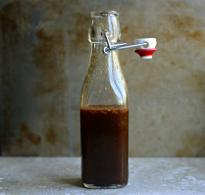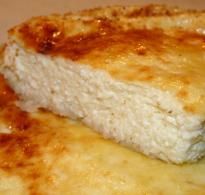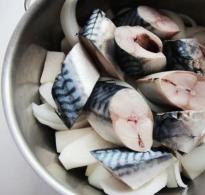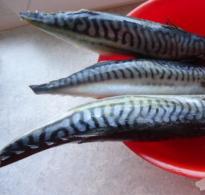How to quickly clean squid. How to peel squid and cook them deliciously in two minutes
Squids are not a product of everyday demand, but in recent years this exotic mollusk has begun to appear more often on the tables of our compatriots. Mistresses, wanting to pamper the household original dish, they choose squids. Some of them, having bought frozen carcasses in the supermarket, do not even know how to approach them.
Cleaning and cutting squid at home takes a lot of time and discourages cooking from them in the future. By learning some secrets, you will be able to "handle" seafood without the hassle.
Preparation: selection in the store, storage at home
The secret to making a delicious squid dish is their right choice. Food that has been frozen several times is more difficult to clean and has lost its taste qualities. How to recognize the "correct" squid?
- Firstly, carcasses should not be frozen to each other. The seller should easily separate them, and not "tear off" from the bulk.
- Secondly, the meat should have a beautiful white color. A red-blue tint is released by the skin during thawing.
It is better to cook purchased squids on the same day or, without defrosting, send them to the freezer.
We clean thawed squid from the film
Occasionally in stores you can get on already thawed squids, and sometimes it also happens that the clams are thawed at home, waiting for the hostess to be free from other things. Do not be discouraged, and in this situation you can cook a delicious dish. The main thing is to follow the procedure:
- Boil an incomplete pot of water.
- After making an incision along the carcass, gut it.
- Rinse meat thoroughly.
- Dip the squid into the pan and hold for 10 seconds.
- After pulling out the carcasses, you will find that the transparent shells remained in the water.
Video tips
How to clean frozen squid
This procedure is done in five steps:
- Bring a half pot of water to a boil.
- Get the squids out of the freezer and fold a deep container (bowl, pan).
- Pour boiling water over carcasses. Due to this action, almost the entire skin will separate itself.
- Quickly drain the water and rinse the seafood under cold running water, carefully removing the film. If you do not hurry, the carcasses will boil.
- Gut the insides, remove the backbone.
How to clean freshly caught clams
The best squids are those that were not frozen, but were brought from the seabed directly to the kitchen, or they were cooled for several hours before being sold. The meat of such mollusks is nutritious, healthy and tasty.
Some housewives in this case are frightened by the presence of a head and tentacles, because they will have to be removed on their own. This procedure does not require special skills. The head is cut off and discarded, and the tentacles are cut off near the eyes and used to cook the dish. They also have a shell, and it will need to be removed in the same way as with a thawed carcass.
The procedure for cleaning fresh squid carcasses and tentacles is as follows:
- Boil required amount water.
- The clams, freed from the insides, are placed in a colander, doused with boiling water, and then placed under a stream of cold water.
- The film is removed by pulling from the thick part towards the thin one. It is more convenient to scrape off the wings with a knife.
- Clean the tentacles in the same way. This is easy to do, since the skin under the influence of boiling water will separate on its own.
How to cook squid and how much

Exist various ways cooking squid, so I will give the three most simple and popular.
- Bring water to a boil in a saucepan, add salt and spices. On a slotted spoon, lower the carcass for 10 seconds in boiling water, then remove it. Cook the rest of the carcasses in the same way. It turned out a semi-finished product for further cooking (slicing into salad, stew, etc.).
- The second method is suitable for cooking frozen, previously peeled blanks. All carcasses are lowered into boiling water with spices, kept on low heat for 1 minute, turn off the stove and let stand in hot water 10 minutes more.
After boiling water, put thawed clams into it, turn off the fire and let it stand for 10 minutes.
Video recipe
- On various sites, it is advised to cook squid for about 4 or even more minutes. Doing this is not worth it! Overcooking will make seafood tough. Moreover, it will lose nutritional value and taste.
- For flavor, half a lemon or a bag of black tea is added to the water in which the mollusk will be boiled.
- When removing films, keep in mind that both colored and transparent casings must be removed. If the hostess does not notice or deliberately leaves the film, then after cooking the meat will be tough and tight.
- Don't buy large calamari. Their meat has a bitter taste, and the preparation of such giants will take more than an hour. Wherein ready meal will be tough.
The nutritional value of seafood cannot be overestimated. Squid meat is a storehouse of vitamins and minerals. There is a great variety of dishes that can be prepared from this mollusk. It is a valuable component of many salads; it is stuffed, stewed, fried, boiled, baked, salted and even marinated. If you decide to please yourself and your family gourmet dish from squid, now you can do it without much difficulty, based on my advice.
Squid - cephalopod, predatory mollusk , living in warm, southern seas. Most often, carcasses are eaten, although the tentacles are also edible. This one is rich low calorie seafood phosphorus, protein, calcium and iodine. There are a lot of squid cooking techniques - they are boiled, fried, stewed, canned, dried. Moreover, it is very simple to cook these mollusks, you just need to know how to clean squids and also how to properly heat treat in order to preserve original taste.
To take or not to take? Or which squids are worth buying.
“What a fish, such an ear,” people say. This is true for squid as well. To enjoy a delicious dish, you need to choose a good original product. The sea delicacy is sold most often in frozen form, chilled specimens are less common.
Determining the quality of a chilled product is not difficult - the top, colored film should be easily removed, and the color of the carcass under the skin should be exceptionally white. If blue or pink shades are present, the squid is stale.
The squid has 3 hearts connected to tentacles. And the eyes of some specimens are of different sizes.The classic case is frozen squid. This is the most convenient method of storing shellfish. However, only the product that is frozen once in fresh, and then did not allow defrosting during storage. If the carcasses are prepared and stored correctly, they will be effortlessly separated from each other, but if the product has already been defrosted, it will be difficult to separate it into separate copies. It is also worth paying attention to the position of mollusks in a frozen briquette - in production they are laid in even, neat rows.
You can often find squid tubes in stores - already peeled, beautiful carcasses. When purchasing such a product, it should be noted that when cleaning in production, it is used heat treatment, and this tender meat terribly dislikes high temperatures. Therefore, such a "convenient" purchase is likely to disappoint you with the rigidity of the final dish.
How to prepare whole squid
Probably the most important thing in preparing squid is to know that they cannot be thawed “quickly”, with the help of microwave oven or hot water. Frozen carcasses should be left on the kitchen table (or better in the refrigerator to avoid sudden changes) and wait until they become soft.
It is not necessary to completely defrost the product; it is just more convenient to clean the squids if they are a little frozen.- Firmly holding the squid by the body with one hand, with the other we carefully separate the insides from the walls, sticking a finger inside the body.
- We take out everything that we managed to separate by pulling on the tentacles.
- We wash the bodies of mollusks under running (maximum cold) water, removing the remnants of the insides.
- The second part is cut in the area of \u200b\u200bthe eyes. We throw away the waste, and look for a beak at the junction of the tentacles - it is easily removed by pressing a finger.
How to clean squid from the film
There are several cleaning methods. Each of them has both advantages and disadvantages. So what is the best way to clean squid?The first and most gentle method is to remove the films manually. You just need to pick up the skin with a knife at the wide edge of the tube and pull it, removing it like a case. If the squid has been frozen for a long time, the films can tear in the hands and then you have to clean them with a knife.

It seems that the carcass is already clean, but this impression is false. The mollusk is also covered with a thin, transparent film, which must also be removed.
The body of the squid along its entire length is supported by a cartilaginous plate (gladius), resembling plastic. She effortlessly pulls out of the carcass.
The second cleaning method is much faster. You just need to boil water and lower the squid into it for 1 second (no more !!!). The films will immediately curl up, they can be easily removed from the carcass.
The third way is a contrast shower. The blanks must be placed so that the water can immediately drain, for example, into a sink or colander, and then scald the squid with boiling water. Pour it over immediately afterwards. ice water. The tentacles are cleaned in the same way, with the only difference being that you have to tinker with removing the suckers.
It is best to process under a stream of cold water so that small particles of the film are immediately washed off and do not stick to your hands. You can clean squid after boiling. It is enough to rub them with a soft brush, removing the curled pieces of the film.
How to cook squid properly
This tender meat categorically does not tolerate long-term exposure to high temperatures, which makes it look like a hard meat. chewing gum. Therefore, boiling carcasses is not recommended. The most optimal solution is to stock up on slightly salted boiling water, dip the squids into it, wait until the water boils again and immediately remove the pan from the stove. It is enough to keep the product in water for 5-7 minutes to cook the meat.

If for some reason the meat is overcooked, it can be saved by boiling on a minimum heat for 40-50 minutes. The taste will remain the same, but, unfortunately, some trace elements will evaporate with steam. To add flavor to the water, you can add dill, fennel or a slice of lemon.
Boiled squids are often used for salads or cold appetizers.What if it's fried?
No less tasty Marine life and fried. It is necessary to fry in hot oil for 3-5 minutes, after cutting them into rings or strips about 5 mm thick. For more tender dish, blanks can be dipped in classic batter(mixture of eggs, milk and salt).
Shellfish acquire a very original taste when grilled on coals.
In most recipes, meat is recommended to marinate, for example, in a mixture of 1 tbsp. olive oil, 1 tbsp. lemon juice, 100 grams of dry white wine and spices to give finished product fragrance and avoid dryness. With this preparation, you should constantly water the meat with the sauce remaining from the pickling. It turns out healthy barbecue from rings, pleasantly smelling of smoke.Goodies from a sea predator
Calamari stuffed with rice and mushrooms
Ingredients:
- gutted squid carcasses - 4 pcs;
- rice - 80 gr;
- fresh mushrooms - 150 gr;
- butter - 50 gr;
- carrots - 100 gr;
- egg - 2 pcs.
Boil rice. Process the carrots on a fine grater and sauté on the melted butter 3-5 minutes. Mushrooms cut into small pieces and fry in sunflower oil.
Boiled eggs cut into cubes. Mix rice with eggs, add carrots and mushrooms. Put the prepared tubes in hot water, fill them with rice mixture, chop off the place of stuffing with toothpicks and bake in the oven for 20 minutes.

Seafood salad with creamy garlic sauce
- squid - 100 gr.;
- cheese hard varieties- 60 gr.;
- crab sticks- 100 gr.;
- eggs - 2 pcs.;
for the sauce:
- garlic 2 teeth;
- butter - 50 gr.;
- fat cream 100 gr.;
- slice of lemon.
boiled squid, eggs, hard cheese cut into cubes, crab sticks into circles, add green onion. For cooking creamy garlic sauce fry thin slices of garlic in butter, add cream, stew a little (5-10 minutes), cool, dilute with a drop of lemon juice and, if desired, spices.
Sea rings in batter with sauce
- frozen squid - 500 gr.;
- egg - 1 pc.;
- milk 3 tablespoons;
- hard cheese - 100 gr.;
- sour cream - 200 gr.;
- breadcrumbs - 3 tablespoons;
- flour - 3 tablespoons;
- garlic - 1 clove;
- refined sunflower oil, ground black pepper, herbs, salt.
Boil squid tubes, cut into rings. For batter, combine the egg with milk and salt a little. For breading - mix breadcrumbs and flour in equal proportions. Fry squid in in large numbers oil (it is necessary that the oil completely covers the rings), dipping first in batter, and then in breading. For the sauce, grate the cheese on a fine grater, add crushed garlic, herbs and dilute it all with sour cream.
Properly cleaned and cooked seafood will allow you to create incredibly tasty and healthy culinary masterpieces, which will not leave indifferent either the layman or the inveterate gourmet.
A bunch of original recipes seafood dishes remain unused if the hostess does not know how to clean squid at home correctly and quickly. But you only need to decide once to experiment and learn simple process. In the future, a healthy and nutritious squid will become the best part variety of salads, will decorate the table fried, boiled, stewed or pickled.
For delicious and healthy seafood on the table, you need to choose it correctly in the store. It depends on how easy the films are to be cleaned and how tender the cooked meat is. It is not recommended to buy peeled squids, since part nutrients already lost, and the taste will be much worse.
- You need to choose not large individuals, but smaller ones. Then you can avoid the effect of rubber meat, the skins will be easily removed.
- If frozen squids were stored with violations and have already been thawed, they will be bitter when cooked, so you only need to pick up carcasses that have not stuck together.
- It is necessary to ensure that the meat is under the film white color. If temperature regime not supported, it will become the color of the film - bluish or pinkish.
Sometimes the carcasses lie on the display case for a sufficient time to change the taste. To be sure of the correct storage, offer the seller to serve you carcasses from the briquette. If you are refused under the pretext that they “do not tear off”, then such a product does not suit you, you need to purchase properly frozen squids.
- Before cooking, the meat must be kept frozen, then the taste will be preserved, and it will be easy to clean.

How to remove the film from frozen squid?
The process is incredibly simple.
- Prepare a pot of boiling water.
- Take the squid out freezer and put them in a bowl.
- Pour boiling water over seafood. At the same time, almost all of the skin will come off on its own.
- Immediately quickly drain the hot water and rinse the contents of the bowl under running water, carefully peeling off the remaining film. It is better to act quickly, otherwise squids cook very quickly and can even be cooked if they are not removed from boiling water in time.
- It remains only to remove the insides and the flexible spine.

Is it possible to remove the film from defrosted meat?
There are situations when squids get home already defrosted. summer heat and unforeseen delays along the way should not prevent you from preparing a delicious dish. To do this, you need to perform the following algorithm.
- Prepare a pot of boiling water and seasonings (salt, Bay leaf and pepper).
- Cut the carcass lengthwise and remove the insides.
- Rinse the meat well.
- Boil carcasses in seasoned boiling water for 2-3 minutes.
- Take out the squid. In this case, the films will remain in the water, calving themselves.

How to work with chilled squids?
If the squids were just recently taken from the seabed and they fell into your hands chilled, this is a great success. The meat will be the most delicious and nutritious. However, the difference will be in the presence of the head and tentacles. Squids will have to be cleaned on their own at home. If the head needs to be permanently removed, the tentacles can be eaten. They are cut off at the very eyes. There is also a film on them, the principle of working with it is the same as for a whole carcass.
And to clean the skins, you need to perform a number of simple steps.
- Prepare a pot of boiling water.
- Put the squids with the insides and the chord already removed in a colander, pour boiling water over, and then immediately cold water.
- Pull the skin from the larger part to the thin one, just scrape off the wings.
- Treat the tentacles in the same way. The only difference is that it will be even easier to remove the film, it will practically come off by itself under the action of boiling water.

Ready-made squid carcasses can be cooked most different ways. They can be boiled for several minutes. strong fire or about forty minutes on the weak. You can fry thin rings separately and with vegetables. They are delicious if the meat is marinated, stuffed, stewed and baked. In this business, the main thing is to precisely control the process so as not to overdo it with heat treatment: no one likes tough meat with a rubbery taste. The time that the carcasses spent under boiling water also counts.
You have to be careful when filming. Both colored and transparent are subject to removal. If you leave a piece and cook meat with it, the piece will be hard and compressed. Properly processed seafood will become a real delicacy that can become a gourmet dish. haute cuisine cooked at home.
Squids are useful and delicious seafood, with which you can diversify the daily family diet. Some housewives do not like to cook these clams, thinking that they are difficult to clean. It's a delusion. Squids are easy to clean if you know the little secrets of their processing.
If you bought a fresh whole squid, put it in a bowl and determine where the head is. It has tentacles on it. Holding the body of the squid with one hand, pull the head towards you with the other. It will separate along with the insides. Turn the head with the tentacles towards you, find and remove the beak. Then remove the eyes. To do this, cut the tentacles into two halves or simply squeeze the eyes out. Clean the carcass from the films. At fresh squid it comes off easily in one go. Remove the hard chitinous plate that is inside the body. Rinse the cleaned carcass well with cold water. More often you have to butcher frozen squid. So that their cleaning does not take much time, choose the right product in the store. Carcasses of frozen mollusks should be easily separated from each other. If they stick together, then the squid has already been defrosted. When cutting, they will spread, and after cooking - bitter. The size and color of the squid depends on its habitat and age. The body of an unpeeled mollusk is covered with a film on the outside and inside. It can have colors ranging from pink to burgundy and purple. Under the film is white meat. After re-freezing, the meat turns gray and loses its taste. Small squids are easier to clean than large ones, and after cooking they are softer. Often, already gutted frozen carcasses are sold in stores. This makes them easier to clean. Remove the cartilage from the butchered squid. Then remove the film from the carcass. If this is not done, during heat treatment they will become tough, and the carcass itself will shrink. There are several ways to clean the film. Without defrosting the squids, put them in a bowl, scald with boiling water, and then immediately transfer to a bowl with ice. The skin will come off like a stocking. You can not put the squid in ice, but simply pour boiling water over them and immediately drain the water. The film rolls up instantly and peels off easily. To remove the skin from a thawed carcass, put it in a pot of boiling salted water and cook for 2 minutes. The film partially remains in the water, and the remaining film is easily removed when the carcass is washed in cold water. After that, the squid is ready to eat. Its meat is soft and tender.Peeled squids can be baked, boiled, fried, marinated, dried, smoked, minced. Do not deny yourself and your loved ones the pleasure of eating delicious meals from this valuable seafood.
If you are cooking festive table or just decided to diversify home menu, then squids are your main assistants in this difficult task. These cephalopods have such a set of properties that it's time to envy the plantain. Beneficial features mollusks are preserved only if hostess knows how to clean squids and cook them properly.
 In their tender meat contains elements such as phosphorus, magnesium, potassium, calcium, zinc, copper. Due to the low calorie content (approximately 90 kcal per 100 g), fans diet food can finally afford to give up from the disgusted boiled breast without skin, and athletes appreciate their meat for high content squirrel. In addition, they have a beneficial effect on blood vessels and the functioning of the thyroid gland.
In their tender meat contains elements such as phosphorus, magnesium, potassium, calcium, zinc, copper. Due to the low calorie content (approximately 90 kcal per 100 g), fans diet food can finally afford to give up from the disgusted boiled breast without skin, and athletes appreciate their meat for high content squirrel. In addition, they have a beneficial effect on blood vessels and the functioning of the thyroid gland.
Get the most out of it dietary product is possible only on condition that you received the original product in good condition. It's no secret that frozen food in stores often suffers from improper storage, being thawed and refrozen many times. What kind of squid would love this?
Product selection in the store
If you are unlucky with housing on the seashore, then you can only dream of a fresh, freshly caught squid, and you can search for its ice cream counterpart in the store.
In stores, as a rule, they offer two options:
- unpeeled mollusks, covered with a film and with entrails, but already without a head and tentacles;
- completely cleaned, and ready for further culinary procedures.
Pros and cons of peeled squid
 Completely purified product, of course, more attractive in terms of use: no need to waste time cleaning and gutting. However, attention should be paid to how, in fact, industrial cleaning takes place.
Completely purified product, of course, more attractive in terms of use: no need to waste time cleaning and gutting. However, attention should be paid to how, in fact, industrial cleaning takes place.
This process uses special machines. Carcasses are placed in a tank with hot water(from 45 to 70 ° C), enzymes and salts are added to the same water, which dissolve mucus and pigment. Then the blades of the tank mix all its contents until the carcasses, in contact with the walls of the tank and each other, are cleared of the film. This process is long, so the tanks are usually very voluminous (about 700 liters), and in an hour such a machine produces 120 kg of carcasses prepared for further packaging.
Cons of industrial cleaning:
- due to a long stay in hot water, the meat becomes rubbery;
- due to the enzymes and salts used, suffer useful qualities meat, and also its taste changes.
Therefore, if the taste of the final dish is important to you, it is recommended to choose more unpeeled cephalopods, the more there is simple ways clean the squids.
Appearance rating
In the store, carefully study the offered assortment. By appearance shellfish, you can learn a lot about whether they were stored correctly.
Do a few simple tests:
- Take the package in your hands and turn or shake it a few times. Packaged squids should separate easily. Sticky carcasses indicate that they have been thawed and frozen again several times, and after cooking the meat will be bitter.
- Look at the color. White color is inherent soft meat, but the lilac or red clams most likely died a natural death, and the final product will be tough, like a car tire.
- Visually evaluate the size. Small squids 5-6 cm long - fry - are suitable for cooking whole, adults are usually 25-50 cm long. The smaller the carcasses, the easier they are to clean, and the larger ones often become rubbery after cooking.
- Smell the carcasses. Fresh carcasses have pleasant sea scent, and old or improperly stored ones smell extremely unpleasant, and they should not be eaten.
Mollusks of white color and medium size, possessing pleasant smell- this is the catch that is not ashamed to bring home.
Description of ways to clean squid
There are several ways to properly clean squid. Frozen squid must be thawed before cleaning.
Proper defrosting
 The right way number 1 - for the leisurely. There is no need to start cooking immediately after the frozen product is at your place, then put the carcasses in a deep plate, cover with cold water and leave overnight in the refrigerator. Water must completely cover carcasses.
The right way number 1 - for the leisurely. There is no need to start cooking immediately after the frozen product is at your place, then put the carcasses in a deep plate, cover with cold water and leave overnight in the refrigerator. Water must completely cover carcasses.
Correct way #2 is "rational". Squids can be thawed outdoors at a temperature of 18-20 ° C, and in this case, the meat will retain a maximum of useful properties.
Wrong way number 1 - "here and now." Defrosting in hot water is more fast way, however, it must be remembered that under the action of hot water, the pigment from the skin gets into the meat, due to which it acquires pinkish or lilac color and starts to fade.
 Wrong way number 2 - "money down the drain." Some habitually defrost squid in the microwave. Immediately after defrosting in the microwave, the carcasses can be thrown away like pieces of rubber unsuitable for food, and the kitchen must be thoroughly ventilated from an unpleasant odor.
Wrong way number 2 - "money down the drain." Some habitually defrost squid in the microwave. Immediately after defrosting in the microwave, the carcasses can be thrown away like pieces of rubber unsuitable for food, and the kitchen must be thoroughly ventilated from an unpleasant odor.
So, the clams are defrosted. The following steps: butchering, gutting, cleaning.
If you got the squid with a whole carcass, then you need to separate everything superfluous from it:
- The head must be cut off. It is not used for food.
- The tentacles can be eaten, but they must be cut off at the base, near the eyes. Note that beak-shaped jaws (the so-called middle beak) are placed between the tentacles. He is not edible. Be sure to remove it and check for debris.
- After cutting, it is necessary to pull out the insides along with a hard chord and rinse the remaining carcass well. Now you need to remove the skin from it.
Skinning
The film from the squid must be removed both from the outside and from the inside. The outer film has a dark color and is clearly visible. The inner film is usually transparent (or white at the edges and in places of seals).
Here are three ways to skin a squid:
- "Stocking" method. The outer film on the thawed carcass is pulled off with a knife and pulled together like a stocking. If there is no need to maintain the shape of the carcass (for example, it is not planned to use squid rings), then the carcass can be cut from the side opposite to the chord and scrape off the inner film with a knife. This method is only suitable for fresh and fresh-frozen clams. Otherwise, the outer film will tear, and it will not work to remove it with a “stocking”.
- Contrast shower method. How to remove the film from the squid if the trick with the stocking failed? Take two deep bowls and fill them with water: one hot, the other ice cold. You can even use ice cubes. Immerse the squid carcasses for a few seconds, first in hot water, and then in ice water. The residence time in hot water must be very short so as not to cook the carcass in an uncleaned form. The peel will burst and begin to curl, after which it will be easy to remove it with your hands or with a soft brush under running water.
- pre-cooking method. How easy is it to peel squids if they are not the first freshness? For shellfish that have been frozen for a long time, another method is suitable. Put a pot of water on the fire. Immerse the carcass in boiling water for no more than 1 minute to boil slightly. Then take it out and let it cool. After this treatment, the squid skin is washed off plain water from the tap. When cooking further, take into account the time spent for pre-brewing squid. Total time heat treatment shellfish should be no more than 4 minutes.






